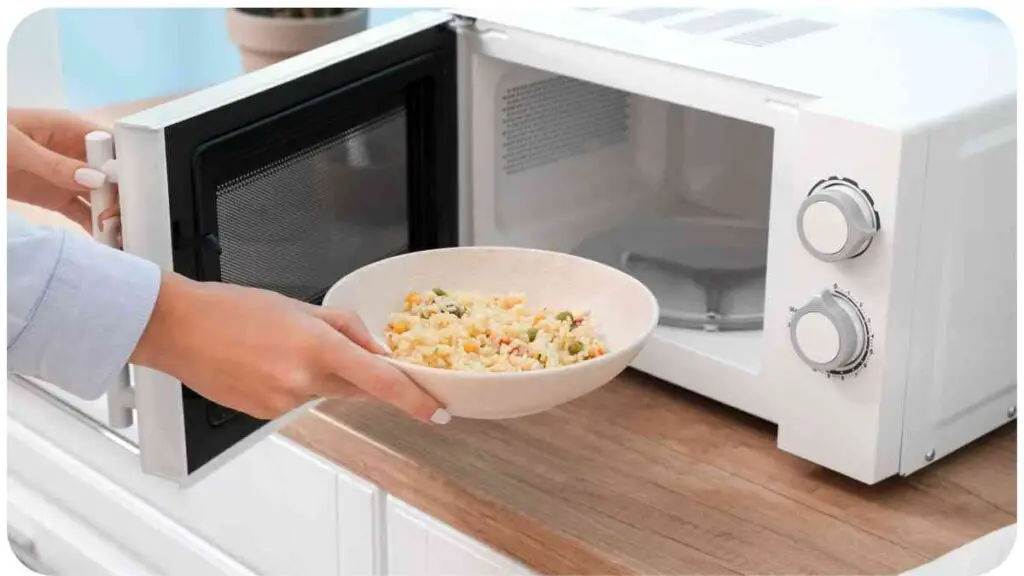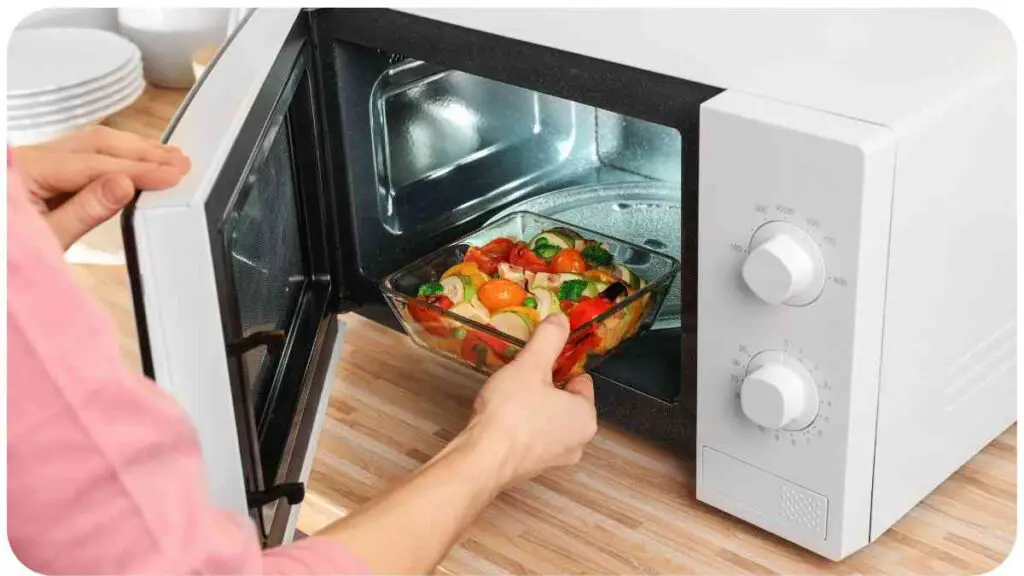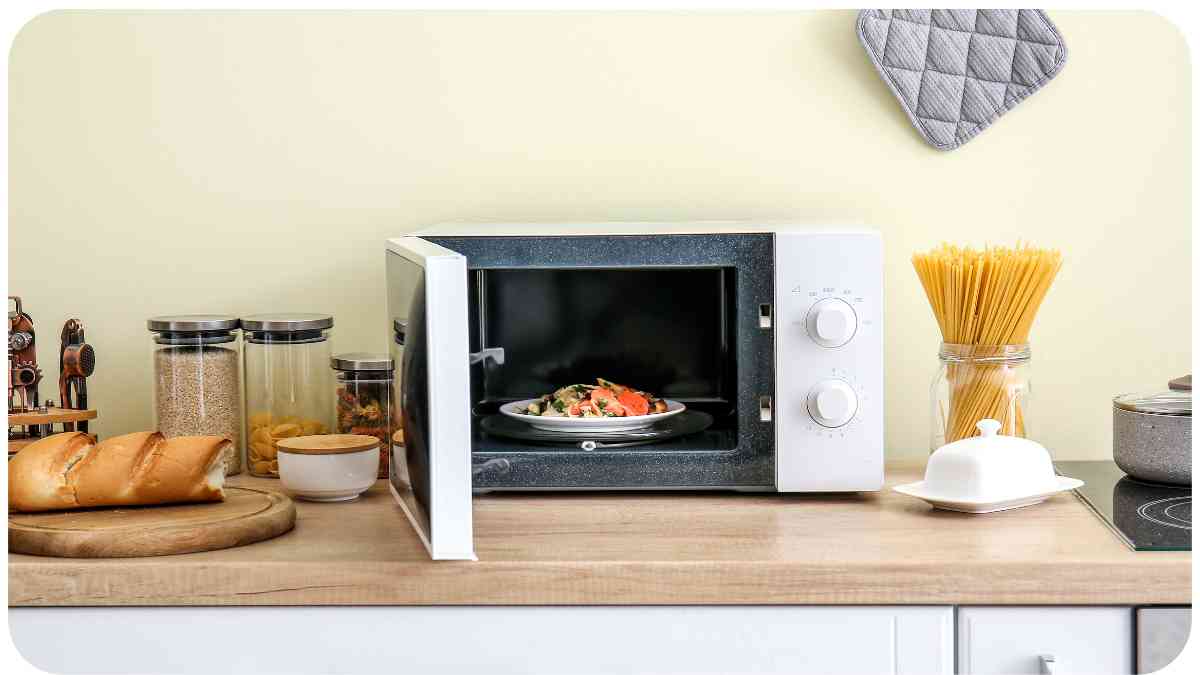Microwaves have become an essential appliance in our kitchens, providing quick and convenient heating for a wide range of foods. However, anyone who has used a microwave knows how frustrating it can be when your food heats unevenly.
One corner is piping hot while another remains cold or lukewarm. In this article, we will explore the reasons behind uneven microwave heating and provide practical solutions to fix this issue. Whether you are an experienced cook or a microwave novice, we’ve got you covered.
| Takeaways |
| Understand the principles of how microwaves work to heat food |
| Placement of food in the microwave can affect heat distribution |
| Adjusting power settings can help achieve more even heating |
| Check and ensure proper functioning of the turntable |
| Regular cleaning and maintenance of the microwave is essential |
| Consider consulting a professional if troubleshooting methods don’t work |
| Choose a microwave from recommended brands for even heating |
| Follow best practices like using microwave-safe containers and covering food appropriately |
| Incorporate rotating, stirring, and letting food stand to promote even heating |
| Address hot spots by repositioning the food during heating |
Understanding Microwave Heating
How Microwaves Work
Before we delve into the reasons for uneven heating, let’s briefly understand how microwaves work. Microwaves use electromagnetic radiation to heat food. They emit microwaves, a type of non-ionizing radiation, which excite water, fat, and sugar molecules in the food. As these molecules vibrate and generate heat, the food warms up.
Learn the secrets of fermentation by making your own kimchi and kombucha. These probiotic-rich foods are a great addition to your cooking repertoire, introducing unique flavors to elevate your dishes.
Common Heating Issues
While microwaves are designed to heat food evenly, several factors can lead to uneven heating. These issues may include problems in food placement, microwave power, age of the microwave, or a malfunctioning turntable. Let’s explore these reasons in more detail to troubleshoot and fix the uneven heating problem.
Reasons for Uneven Heating
Placement of Food
The way you place your food inside the microwave can affect the heat distribution. Placing larger or thicker sections towards the outer edges can cause uneven heating. Additionally, dish size and shape can play a role. Microwave energy tends to be more concentrated towards the center, so using a larger, flatter dish can help promote more even heating.
Microwave Power

The power level you choose plays a crucial role in achieving even heating. Running your microwave at high power for a longer duration might cause the outer layers of food to get excessively heated before the center catches up. Lowering the power level can help distribute the heat more evenly and prevent overcooking the edges.
Embrace the rise of plant-based eating and discover delicious ways to incorporate more veggies into your diet. Find inspiration for healthy meals that will nourish your body and support a sustainable lifestyle.
Age of Microwave
Over time, the efficiency of microwaves can decline, leading to uneven heating. If you’ve been using the same microwave for several years, it might be worth considering an upgrade. Modern microwaves often have improved technology that ensures more uniform and efficient heating.
Malfunctioning Turntable
Microwaves typically come equipped with a turntable that rotates the food to ensure more even heating. If the turntable doesn’t function properly, certain sections of the food might remain stationary and receive more heat than others. Take a look at your turntable to ensure it is rotating smoothly. If not, it may need to be repaired or replaced.
| Rank | Microwave Model | Features |
| 1 | Panasonic NN-SN966S | Inverter technology for even heating |
| 2 | Toshiba EM925A5A | One-touch cooking presets for even heating |
| 3 | LG LCRT2010ST | TrueCookPlus technology for even heating |
| 4 | Breville Quick Touch | Sensor IQ technology for even heating |
| 5 | Samsung MS14K6000AS | Ceramic enamel interior for even heating |
Troubleshooting and Fixing Uneven Heating
Now that we’ve identified the potential causes of uneven heating, let’s explore some troubleshooting and fixing methods to help you achieve more uniform results.
Rotating and Stirring Food
When heating food in the microwave, incorporating frequent rotating and stirring can help distribute the heat evenly. Pause the microwave every 30 seconds or so and rotate the dish. This simple technique ensures that all parts of the food receive equal exposure to the microwaves.
Looking to simplify your home cooking? Check out the ultimate guide to meal planning. With helpful tips and strategies, you can save time, reduce stress, and ensure you have delicious meals ready to enjoy.
Adjusting Power Settings
Experimenting with different power levels can significantly improve the heating experience in your microwave. Lowering the power level and increasing the duration can help mitigate uneven heating. Start with a lower power level and increase in increments until you find the setting that works best for your food.
Checking and Replacing Turntable
Inspect the turntable in your microwave to ensure it is functioning properly. It should rotate smoothly without any obstructions. If you notice any issues, such as a misaligned or stuck turntable, you may need to repair or replace it. Contact the manufacturer or a professional technician for assistance.
Regular Cleaning and Maintenance
A clean microwave is essential for optimal performance. Food splatters and residue can disrupt the distribution of heat, leading to uneven heating. Regularly clean the interior of your microwave using mild soap and water or a microwave-safe cleaning solution. Wipe down the turntable, walls, and ceiling to remove any built-up grime.
Consulting a Professional
If you’ve tried all the troubleshooting methods and your microwave still heats unevenly, it may be necessary to contact a professional technician. They have the expertise to diagnose and fix any underlying issues with your appliance. Don’t hesitate to seek professional help to ensure safe and efficient operation.
Don’t worry if you’ve burnt your soup, there are easy recovery methods! Find out how to save the day with this guide on fixing a burnt soup. Soon, you’ll be enjoying a perfectly cooked and flavorful soup again
Recommended Microwave Brands for Even Heating
Choosing the right microwave can make a significant difference in achieving more uniform heating. Here are some top microwave brands known for their even heating capabilities:
These brands are renowned for their commitment to quality, design, and functionality. They prioritize even heating and offer a range of features to enhance your cooking experience.
Tips for Optimal Microwave Usage

Aside from troubleshooting and selecting the right microwave, there are some additional tips that can help you achieve optimal results when using this versatile kitchen appliance.
Using Microwave-Safe Containers
Always ensure that the containers you use to heat food in the microwave are labeled as microwave-safe. Improper containers can release harmful chemicals or melt when exposed to high temperatures, affecting the overall heating process. Look for containers made of glass, ceramic, or microwave-safe plastic.
Covering Food Appropriately
Covering food while microwaving retains moisture and helps distribute heat more evenly. Use microwave-safe lids, microwave-safe plastic wrap, or microwave-safe paper towels to cover your dishes. However, be sure to leave a small vent or opening to allow steam to escape and prevent pressure buildup.
Upgrade your kitchen with the best appliances for healthy cooking. Discover the top choices to enhance your culinary experience in the comprehensive guide on the best kitchen appliances for healthy cooking. Start preparing nutritious meals with ease.
Letting Food Stand and Stirring
After removing food from the microwave, allow it to stand for a few moments before serving. This extra time ensures that the heat further distributes throughout the food, preventing any residual unevenness. Additionally, take a few moments to stir the food gently, redistributing any remaining hot or cool spots.
Correcting Hot Spots
If you notice specific areas that consistently heat faster or slower in your microwave, try repositioning your food during the heating process. Move these hot spots toward the cooler areas or vice versa to achieve a more balanced heating result.
Conclusion
Microwaves are incredibly convenient appliances for heating food quickly, but uneven heating can be a frustrating issue. By understanding the causes behind uneven heating and implementing the troubleshooting tips we’ve discussed, you can enjoy more uniformly heated meals.
Remember to consider the recommended microwave brands for even heating to enhance your cooking experience. With these insights and practical advice, you’ll be able to fix and prevent uneven heating in your microwave, ensuring that every meal comes out perfectly heated and ready to enjoy.
Further Reading
Here are some additional resources that you may find helpful to explore the topic of uneven microwave heating further:
Why Do Microwave Ovens Heat Unevenly?: This article delves into the scientific principles behind uneven heating in microwave ovens. It discusses factors such as electromagnetic waves and food composition, providing a deeper understanding of the phenomenon.
Why Do Microwaves Heat Unevenly?: Temperature Master website offers insights into the reasons for uneven microwave heating. It explains how different parts of food absorb and conduct heat differently, creating the unevenness we often experience.
How Can You Fix an Uneven Microwave?: Quora is a popular platform for asking questions and receiving answers from the community. This thread discusses various methods to fix uneven heating in a microwave shared by individuals who have encountered the issue firsthand.
FAQs
Here are some frequently asked questions to address common concerns related to microwave heating:
Why does my microwave heat certain sections faster than others?
Microwave heating can be uneven due to several factors, including the placement of food, power level settings, the age of the microwave, and potential issues with the turntable. Consider adjusting these factors to achieve more uniform heating.
Can I use any type of container in the microwave?
No, it’s crucial to use microwave-safe containers to ensure safety and proper heating. Using non-microwave-safe containers can cause them to release harmful chemicals or melt, affecting the heating process and potentially damaging the microwave.
How often should I clean and maintain my microwave?
Regular cleaning is essential for optimal microwave performance. It is recommended to clean the interior, turntable, and surfaces regularly using mild soap and water or a microwave-safe cleaning solution to remove food splatters and residue.
Can I fix a malfunctioning turntable myself?
It’s advisable to consult a professional technician if you suspect an issue with your turntable. They have the expertise to diagnose and repair or replace any faulty components, ensuring safe and efficient operation of your microwave.
Are there any tips to avoid overcooking or undercooking food in the microwave?
Yes, some tips include using lower power settings to reduce the risk of overcooking, stirring or rotating the food during heating to promote even distribution of heat, and allowing the food to stand for a brief period after heating to equalize temperature throughout.

Hi, I’m Hellen James! I’m a professional chef who has been cooking for over 12 years. In my career, I’ve worked at some of the world’s most prestigious hotels and restaurants. My expertise lies in creating recipes that are simple but delicious, and I love to experiment with new ingredients and techniques. I started this blog because I want to share my passion for cooking with everyone who loves food as much as I do.


